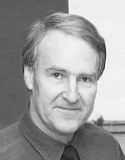 |
Russell A. BellProfessor EmeritusB.Sc. (Wellington), M.S. (Wisconsin), Ph.D. (Stanford), F.C.I.C. Organic Synthesis and Radio-imaging Agents |
Radio-imaging and Magnetic Resonance Imaging (MRI) have become of enormous medical importance in the past few years, particularly in clinical medical practice, and there is a constant demand has for new and more specific contrast reagents. Our interests in the radio-imaging area concern the synthesis of new technetium chelating agents. These reagents are designed so as to be able to be coupled covalently to biologically important molecules (eg. steroids, peptides, carbohydrates) which have particular functions at specific organs or which are directed to specific lesions by the immune system.
The synthesis of chelants uses amino acids as the construction units and offers the ability to prepare a wide range of substrates, the hydrophilic/hydrophobic properties of which may be varied at will. The early detection of cancerous tumors has become very important and we have begun active studies on the incorporation of 99mTc into estrogens, like estradiol, and anti-estrogens, like Tamoxifen, as candidates for the imaging of breast cancer tumors. The general idea is to use the biologically active molecule as a carrier to effectively transport the radioactive 99mTc to specific organs (eg. gall bladder, kidney, heart) and image only that organ.
An active collaboration is maintained with the Radiology and Nuclear Medicine Departments at McMaster and in vivo studies of the compounds prepared are undertaken. A student entering this kind of broad ranging project can expect to become involved in organic synthesis, structure determination (including 1H and 13C nmr spectroscopies and X-ray crystallography), handling radio-isotopes, and, if interested, exploring the biology and pharmacology of the compounds prepared.
The same ideas hold for MRI contrast reagents except that here the metal cation used is paramagnetic (eg Gd(III), Fe(III)) and the contrast reagent changes the nmr relaxation times of the water and fats present in living tissues. Our interest has been to synthesize new classes of metal cation relaxation agents where the unpaired spin density of the metal is transmitted to the outside of the organic chelant and where direct interaction with water molecules can take place. Such compounds show greatly enhanced relaxivity and the metal-complexed aminotroponiminates are an example of molecules which show such effects. Interesting routes to these molecules involve the use of photochemical rearrangement of aromatic diamino-azides.
Selected Publications:
- Charles Younger and Russell A. Bell. "Photolysis of 3,4-Diamidophenyl Azides: Evidence for Azirine Intermediates." J. Chem. Soc. Chem. Commun. 1359, (1992).
- Russell A. Bell, Alfredo Capretta, Howard N. Hunter, and Christopher S. Frampton. Synthesis, "NMR Spectroscopy, and Crystal Structure of [9](N6,9)-6-Aminopurinophane." Can. J. Chem. 71, 96-106 (1992).
- P.K. Rangachari, T. Prior, R.A. Bell, and T. Huynh. "Potentiation of histamine responses by hydroxylamines: structure-activity reactions; inhibition of diamine oxidase." Am. J. Physiol. 263 (Gastrointest. Liver Physiol. 26): G632-G641, (1992).
- A. Capretta, R. B. Maharajh, R. A. Bell. "Synthesis and characterizations of cyclomaltoheptaose-based metal chelants as probes for intestinal permeability." Carbohydrate Research 267, 49-63, (1995).
Contact Information
|
Mailing Address: Dr R.A. Bell Department of Chemistry McMaster University Hamilton, Ont., Canada L8S 4M1
|
Telephone: Voice (905) 525-9140, ext. 23479 FAX (905) 522-2509
|
|
Office: ABB-420 Laboratory: ABB-465
|
E-mail: bell@mcmaster.ca |
Chemistry Faculty
Department of Chemistry.
05aug1999; rab